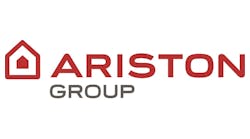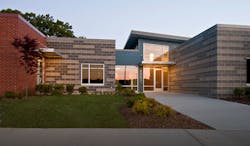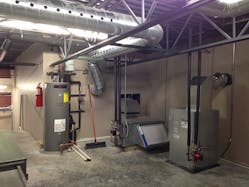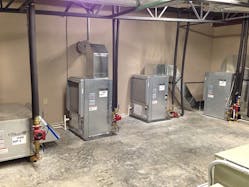COLUMBIA, MO. — CM Engineering in Columbia, Missouri, has earned an international reputation by helping its clients conserve energy and reduce operating costs.
Practical, resource-conserving strategies drive their designs — the same strategies they brought to their new home, an award-winning 12,000-sq.ft. office building that is also home to Simon Oswald Architecture and Working Spaces, an office furniture supplier.
Designed by Simon Oswald Architecture and CM Engineering, the OHM office building the two firms call home is a repository of sound design and engineering practices, along with solid sustainability tactics. In 2015, the city of Columbia honored the new building with the Mayor’s Climate Protection Agreement (MCPA) Award in the Innovative Best Practices category (see video below). Among the innovative best practices incorporated in the building is a one-pipe geothermal design.
Geothermal heating and cooling is not new to CM Engineering, which has been applying the technology to its projects for more than 20 years. During that time, the firm has incorporated a one-pipe rather than a more typical two-pipe geothermal system into its mechanical designs whenever possible.
With every estimate that leaves our office, we make it a practice to include a geothermal estimate and a cost analysis that compares the geothermal system to an air-source or gas system and shows the savings it offers,—Mike Keeven
The system at the OHM building is no exception and relies on 10 WaterFurnace Envision heat pumps (nine Envision2 Compact units and one Envision Console unit) and one other unit to circulate water out to the earth loop or heat exchanger — 18 bore holes drilled 300 feet into the ground and linked together beneath the parking lot. This process warms the water in the winter and cools it during the summer. Combining the heat exchanger with a digitally controlled, high-efficiency pumping system makes the heating and cooling system 30 to 40 percent more efficient than conventional HVAC systems for cooling and 50 to 60 percent more efficient for heating.
The installation
The job of installing the innovative one-pipe system at OHM fell to Mike Keeven, owner of Keeven Heating and Cooling, New Haven, Missouri, along with his brother Larry.
“A one-pipe system like the one at CM Engineering uses a hydraulic separator (pump) at each heat pump to move water in and out of the one-pipe loop,” explained Keeven. “On a mild winter day, the exterior of the building will probably need heat, while the interior may need cooling. With the hydraulic separator, water circulates among all the units and the separator. If the interior loop temperature stays within three degrees of the set point, the water never needs to move to the outside loop field, reducing pumping, operating and initial installation costs per square foot, which in this case are $17 or $18 per square foot, compared to $25 to $30 for a two-pipe system. When part of the building requires heating and part requires cooling, the units help each other out; cooling units add heat to the water, warming exterior office spaces, and units operating in the heating mode put cool water into the loop, helping to cool interior offices.”
Because the one-pipe design uses a single large loop (as opposed to numerous zone loops in a two-pipe system), the design requires fewer pipes, fittings and pumps, reducing installation costs by as much as 50 percent. At the same time, it offers a much simpler system that is easier to maintain, while dramatically reducing energy use and operating costs.
Keeven’s experience with geothermal goes back 22 years when a homeowner approached him about installing a geothermal system in his home. Keeven researched the technology, attended a training program and eventually installed the homeowner’s geothermal system. Today, he estimates geothermal installations make up 90 percent of his company’s business.
“With every estimate that leaves our office, we make it a practice to include a geothermal estimate and a cost analysis that compares the geothermal system to an air-source or gas system and shows the savings it offers,” said Keeven. “I would say eight out of ten customers, even though they said they didn’t want a geothermal system because they thought it would be too expensive, changed their opinion of geothermal when they saw how much it could save them.”
Low-maintenance, long life
Keeven also attributes the rise in his geothermal business to a public that is better informed about the technology, thanks in large part to the Internet.
“They also realize the volatility of fuel prices, which doesn’t apply to a geothermal system,” he said. “Additionally, I discuss with them the longevity of a geothermal system. The bore field will last 100 years and the equipment has a projected life of 25 years, compared to 15 years for air-source equipment. That’s another strong selling point that’s difficult for customers to ignore.”
Mike Boles, project manager at CM Engineering, agrees. “Geothermal systems have a long life span and come with super low maintenance costs,” said Boles. “Once you put one in, you pretty much leave it alone, except to change filters quarterly or as needed in the heat pumps. The system is highly reliable.”
According to Boles, this is especially important when it comes to schools or other businesses that might not employ a specialist in heating, ventilation and air conditioning. “They typically have someone who does everything — making sure boilers work, windows open, doors lock, etc. So when you give him a piece of equipment like a cooling tower that sits outside, that could present a problem. With geothermal heat pumps, you install them, turn them on and leave them alone.”
The eleven heat pumps at OHM provide 25 tons of heating and cooling to the structure. Seven are installed on a mezzanine above the central restrooms (including one unit that provides preheated water for the domestic hot water system), one is installed in the Working Spaces area and three units are installed in the CM Engineering space, where they are part of a display for clients.
“We specified WaterFurnace units because their products always do what they’re supposed to do,” said Boles. “They go in easily, start up easily and maintain the building comfortably and quietly. It’s everything you could want.”
Keeven is just as enthusiastic about WaterFurnace products. “Over the years, WaterFurnace has always been innovative, keeping pace with changes in technology — things like variable speed and web-based thermostats that enable customers to control their system using their smart phones,” he said. “That’s important to me, because when a customer asks for these newer technologies, I need a product that offers them. With WaterFurnace, I am confident I can meet my customers’ needs.”
Strategies promote sustainability
In addition to a geothermal heating and cooling system, the OHM building incorporates a number of other design strategies that conserve resources and promote sustainability:
- Rainwater harvesting system that supplements gray water and irrigation needs, limiting run-off into local storm drains and water ways and reducing the building’s demand on the municipal water system. Rainwater is minimally filtered and taken via separate plumbing lines to restrooms and the landscaping sprinkler system, saving more than 100 gallons per day of potable water for toilet flushing and providing up to 80 percent of irrigation needs during periods of peak demand.
- Desuperheater that provides most of the domestic water heating needs of the facility.
- Roof and continuous wall insulation that far exceeds most industry standards.
- Low-e coated windows with double thermal break frames designed for minimal thermal conductivity.
- Desiccant-based air-to-air energy recovery system that exchanges indoor air 15 times each day, while moving heat energy during warm months and keeping it inside during cold months.
- LED lighting that burns cooler, lasts longer and can be chosen in color temperatures that maximize employee comfort by closely replicating natural light.
- Motion detectors that ensure no lighting energy is wasted in unoccupied spaces. The combination of LED lighting and motion detectors means the building uses less than .4 watts per square foot of power for lighting, compared to 1.0 watts per square foot for conventional fluorescent designs. Additionally, the dimming capability of the lighting allows occupants to dim the lighting to 50 percent of the designed values, resulting in better occupant satisfaction.
- Location that is within walking distance of alternative transportation, increasing the likelihood of employees using public transit.
As a result of these and other energy-saving features, costs to operate the OHM office building are around $30 a day. Additionally, Boles estimates the OHM building will earn an ENERGY STAR rating of 99, which means the building is 99 percent more efficient than other similar buildings in the United States.
“But what makes us most proud is that this building was designed following current best practices and engineering guidelines,” said Boles. “There is nothing incorporated into the design that would be considered radical or experimental, which validates much of the current thinking on what should go into a basic building design.”





